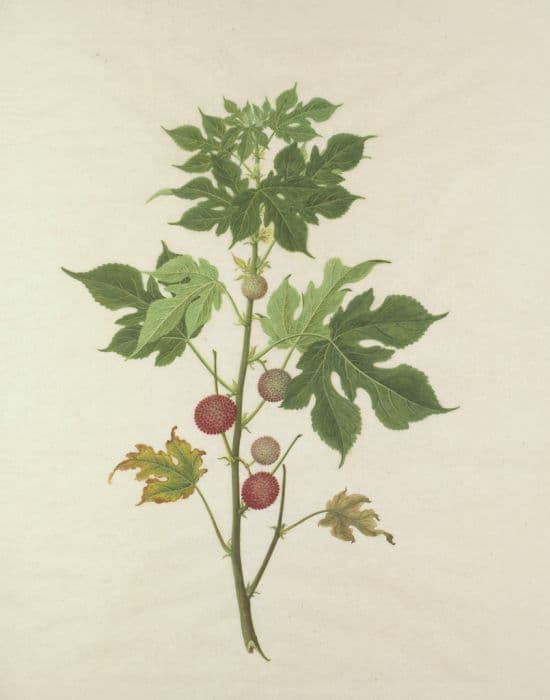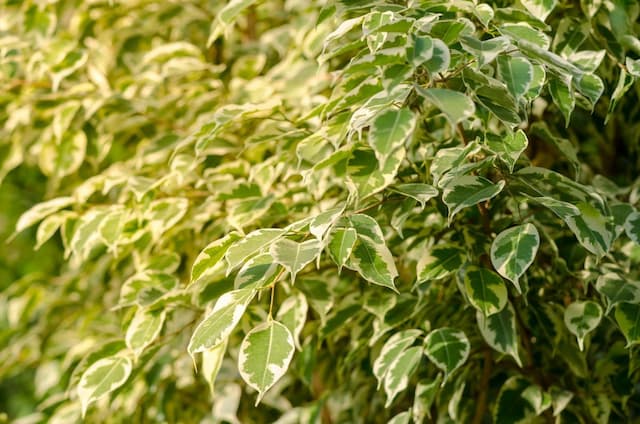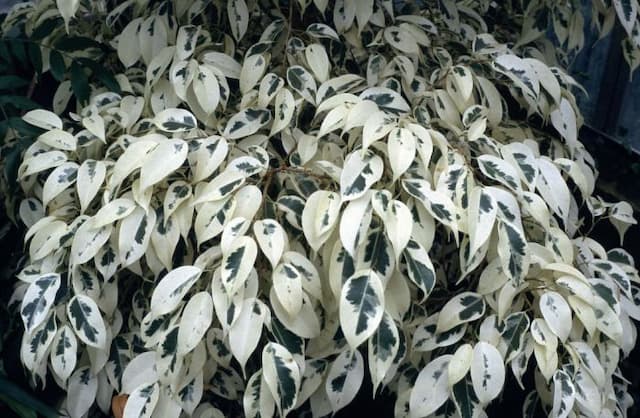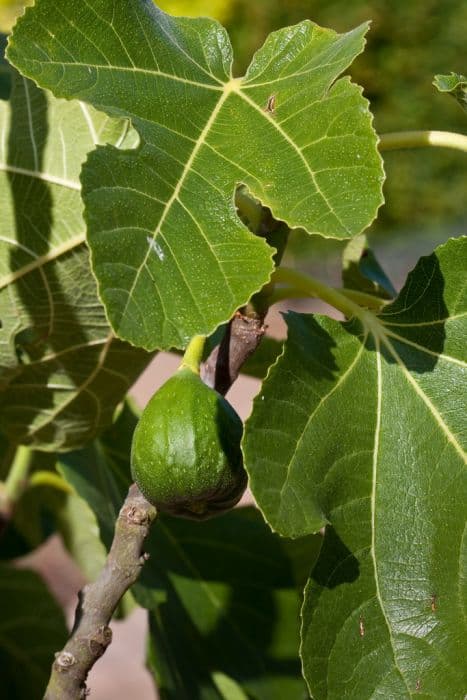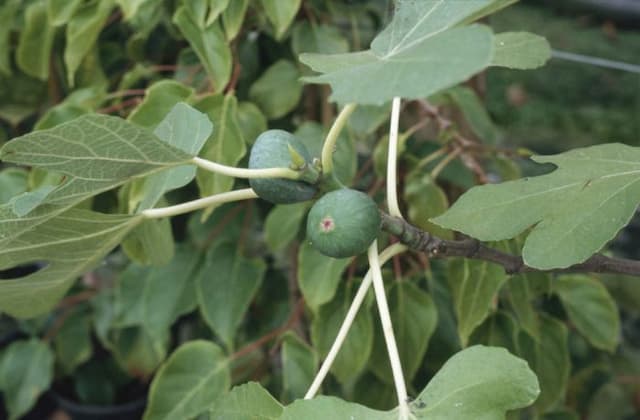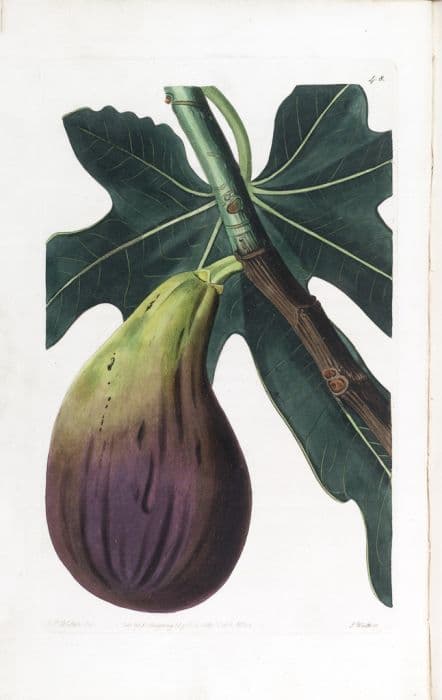Black Mulberry Morus nigra (F)

ABOUT
Morus nigra, commonly known as black mulberry, is a deciduous fruit-bearing tree that has a robust and gnarled appearance, characterized by its furrowed bark which is often dark brown to black in color. The leaves are broad, heart-shaped to ovate, and have serrated margins, showing a luscious green hue. They can display some texture with prominent veins. During the growing season, the tree produces small, inconspicuous flowers which are followed by the fruit. The fruits resemble blackberries and are dark purple to black when ripe, known for being juicy and sweet with a slightly tart flavor. The fruits are commonly enjoyed fresh and are also used for making preserves and desserts.
About this plant
 Names
NamesFamily
Moraceae.
Synonyms
Black Mulberry, Blackberry, European Black Mulberry.
Common names
Morus australis Poir., Morus boutanensis Decne., Morus Moretti Miq., Morus nigra var. australis (Poir.) Bureau, Morus nigra var. caudata (Ser.) Bureau, Morus pabularis Gand., Morus serrata Roxb., Morus sinensis Lodd. ex Loudon, Morus tatarica L.f.
 Toxicity
ToxicityTo humans
Black mulberry (Morus nigra) is generally not considered toxic to humans. The ripe fruit is edible and is often used in jams, desserts, and wines. There is no well-documented toxicity from ingesting the ripe fruit of the black mulberry tree. However, individuals may experience allergic reactions or digestive discomfort, particularly if they consume unripe berries or other parts of the plant in large quantities.
To pets
Black mulberry fruit is not commonly known to be toxic to pets. In fact, the ripe berries can sometimes be given to pets as a treat. However, as with humans, pets could potentially have an allergic reaction or digestive disturbance if they eat unripe berries or excessive amounts of the fruit. It is always best to introduce any new food to a pet's diet gradually and to consult with a veterinarian if you have concerns about the potential effects of black mulberry on your pet's health.
 Characteristics
CharacteristicsLife cycle
Perennials
Foliage type
Deciduous
Color of leaves
Green
Height
30 feet (9 meters)
Spread
30 feet (9 meters)
Plant type
Tree
Hardiness zones
6
Native area
Western Asia
Benefits
 General Benefits
General Benefits- Nutritious Fruit: Morus nigra, commonly known as black mulberry, bears fruit that is rich in vitamins, especially vitamin C, and minerals.
- Edible Leaves: The leaves can be consumed as a vegetable or used for feeding silkworms, important for silk production.
- Shade Providing: Black mulberry trees are known for their broad canopy which provides ample shade during hot weather.
- Ornamental Use: With their attractive leaves and fruit, black mulberry trees are often used in landscaping and garden design.
- Wildlife Habitat: These trees offer habitat and food to a variety of wildlife, including birds and beneficial insects.
- Culinary Uses: The fruit can be eaten fresh, or used in jams, desserts, and wines due to its sweet flavor.
- Soil Improvement: The tree can help with soil enrichment through leaf litter and root decomposition.
 Medical Properties
Medical Properties- Antioxidant: Morus nigra fruit extracts contain high levels of antioxidants, which can help protect the body from oxidative stress and may contribute to overall health.
- Anti-inflammatory: The plant may have anti-inflammatory properties that can be beneficial in reducing swelling and treating conditions associated with inflammation.
- Antidiabetic: Some studies suggest that Morus nigra has potential antidiabetic effects by influencing the metabolism of glucose and insulin sensitivity.
- Antihyperlipidemic: Extracts from the leaves or fruits have been reported to help in managing high cholesterol levels, thus supporting cardiovascular health.
- Antiviral: Compounds in Morus nigra may have antiviral activities, particularly against certain types of the flu virus.
- Antibacterial: Research indicates Morus nigra might exhibit antibacterial properties against a variety of pathogenic bacteria.
 Air-purifying Qualities
Air-purifying QualitiesThis plant is not specifically known for air purifying qualities.
 Other Uses
Other Uses- Woodworking: The wood of the black mulberry is durable and hard, often used for joinery, cabinet-making, and crafting musical instruments.
- Fabric Dye: The fruit of the black mulberry can be used to create a natural dye for fabrics, yielding a range of purples and blues.
- Ink Production: The fruit's juice, rich in anthocyanins, historically served as a base for making ink.
- Culinary Ingredient: Black mulberry leaves are utilized in some culinary traditions as a wrapping material for fermented food items.
- Livestock Feed: The leaves and twigs, when pruned, are given to livestock as an additional food source.
- Ornamental Use: With its attractive foliage and fruits, black mulberry can be grown purely for aesthetic purposes in gardens and parks.
- Environmental Indicator: The presence of black mulberry trees in certain areas can indicate specific soil types or historical land management practices.
- Companion Planting: Black mulberry can be planted alongside other species to attract pollinators or provide shade for more delicate plants.
- Fish Farming: Leaves and twigs from the black mulberry can be used as a natural feed supplement in aquaculture, especially for carp.
- Erosion Control: The deep roots of black mulberry trees help stabilize soil and prevent erosion on slopes.
Interesting Facts
 Feng Shui
Feng ShuiThe Black Mulberry is not used in Feng Shui practice.
 Zodiac Sign Compitability
Zodiac Sign CompitabilityThe Black Mulberry is not used in astrology practice.
 Plant Symbolism
Plant Symbolism- Protection: The Black Mulberry is often associated with safeguarding due to its robust nature and the dense canopy it provides, symbolically offering a shield against the outside world.
- Wisdom: As a plant that can live for hundreds of years, the Black Mulberry can represent knowledge and wisdom accumulated over a long life.
- Patient Growth: This tree grows slowly, which can symbolize steadiness, patience, and the importance of a solid foundation in personal or spiritual growth.
- Health and Healing: With its nutritious fruits and various medicinal uses, the Black Mulberry symbolizes good health and the healing of ailments.
- Fertility and Prosperity: Its abundant fruit production once made it a symbol of fertility and prosperity, as it was believed to bless the land with bountiful yields.
- Sacrifice: In some cultures, because the tree suffers for its fruits, stripping itself bare each season, it can represent the idea of sacrifice for the greater good.
 Water
WaterThe Black Mulberry tree should be watered deeply once a week during the growing season, especially if there has been little to no rainfall. In hot and dry conditions, you may need to water twice a week. Ensure the water penetrates deeply into the soil, reaching the roots; each watering session should provide about 15-20 gallons for mature trees. During the winter months, reduce watering frequency as the tree requires less moisture. It's essential to avoid overwatering as this can lead to root rot.
 Light
LightThe Black Mulberry performs best in full sunlight, meaning it should receive at least six hours of direct sunlight each day. A spot that offers unfiltered sunlight throughout the majority of the day is ideal for this plant. However, the tree can tolerate partial shade, especially in hotter climates.
 Temperature
TemperatureBlack Mulberry trees thrive in a range of temperatures and can survive in conditions as cold as 10°F, making them suitable for many non-tropical climates. They perform best, however, in an environment where the temperature ranges between 60°F and 80°F. A mature Black Mulberry can generally tolerate brief periods of high heat or unexpected frost.
 Pruning
PruningPrune the Black Mulberry to maintain its shape, remove dead or diseased wood, and encourage fruit production. The best time to prune is in late winter or early spring before the sap starts to flow. Remove any crossing branches and thin out dense areas of the canopy to allow light and air to penetrate; this helps reduce disease pressure and promotes healthy growth. Pruning should be done annually.
 Cleaning
CleaningAs needed
 Soil
SoilThe best soil mix for the Black Mulberry tree is well-draining, fertile loam with compost enrichment. The ideal pH for Black Mulberry trees should be slightly acidic to neutral, ranging from 6.0 to 7.5.
 Repotting
RepottingBlack Mulberry trees grown in pots should be repotted every 2 to 3 years to prevent root bounding and replenish nutrients.
 Humidity & Misting
Humidity & MistingBlack Mulberry trees prefer moderate humidity levels but are adaptable to various conditions and can tolerate dry to humid climates.
 Suitable locations
Suitable locationsIndoor
Ensure full sun, prune to manage size, and use large pot with drainage.
Outdoor
Plant in full sun, provide ample space, and protect from strong winds.
Hardiness zone
6-10 USDA
 Life cycle
Life cycleMorus nigra, also known as Black Mulberry, begins its life cycle as a seed, which germinates in the soil under the right conditions of warmth and moisture. The plant emerges as a seedling with a characteristic pair of heart-shaped leaves distinct to mulberries. As it grows into a juvenile plant, it develops a woody stem and branches out, becoming a sapling. Over several years, it matures into an adult tree capable of flowering; the flowers are typically inconspicuous, and pollination is often aided by wind or insects. After pollination, the flowers develop into small, deep purple to black aggregate fruits, which can be harvested during the summer months. The tree can live for several decades, continuously going through annual cycles of growth, flowering, and fruiting.
 Propogation
PropogationPropogation time
Spring-Early Summer
The most common method of propagation for Morus nigra, known commonly as black mulberry, is by taking softwood cuttings in the late spring or early summer. A softwood cutting is a shoot that is not yet mature and typically has a green and flexible stem. To propagate black mulberry from cuttings, take a cutting 4 to 6 inches (approximately 10 to 15 centimeters) in length from a healthy branch, making sure it has at least two sets of leaves. Remove the leaves from the lower half of the cutting to expose the nodes, as this is where roots will develop. Dip the cut end into a rooting hormone to enhance root growth and plant the cutting into a moist soil mixture, ensuring at least one set of leaf nodes is buried. The container with the cutting should be placed in a well-lit area but out of direct sunlight to avoid wilting. Keep the soil consistently moist until the cutting takes root, which is typically evident by new growth at the top of the cutting.
